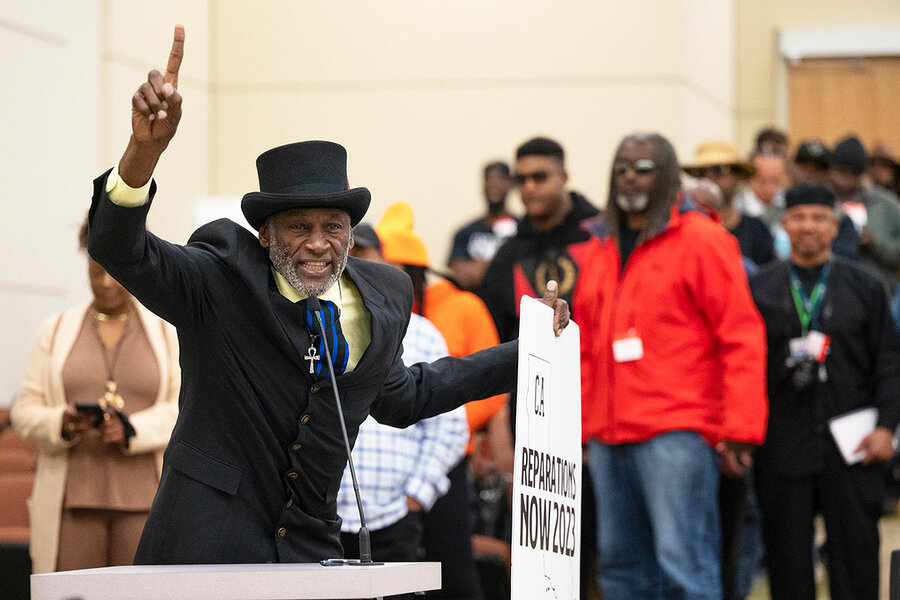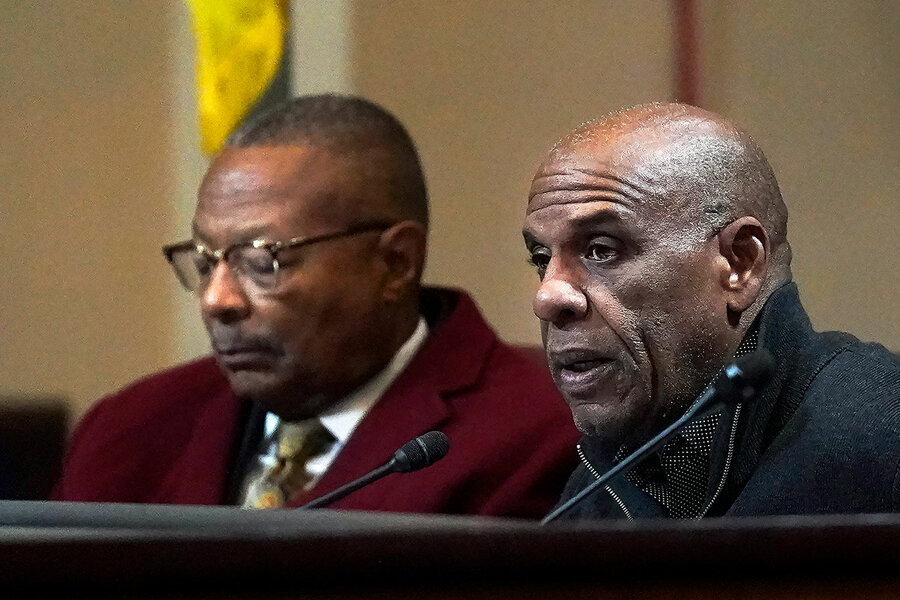Reparations in California: What can lawmakers achieve?
Loading...
| Bakersfield, Calif.
The California Reparations Task Force on Thursday delivered a final report with sweeping recommendations for financial, legislative, and administrative steps toward closing racial gaps in wealth, health, and opportunity.
The nine-member task force, appointed by the governor and legislature, spent two years on its 1,100-page report – the first attempt by a U.S. state to take up the issue of reparations to Black residents. Those involved hope it will become a template for other states.
Why We Wrote This
California is the first U.S. state to take steps toward reparations for harms caused by slavery and institutional racism. With a sweeping report from the state task force, it’s now up to state lawmakers.
State lawmakers and most Californians acknowledge a history of violence and racism in need of correction, in a state not generally linked with slavery. But there’s no consensus on how best to do that, and now lawmakers begin the complex work of administering justice.
In a large and demographically diverse state, the work of delivering myriad legislative reforms is politically fraught, especially when the state is tackling a $32 billion shortfall.
State Senator Steven Bradford, a member of the task force and vice chair of the California Legislative Black Caucus, does not expect immediate legislative action. He references Martin Luther King Jr.’s counsel to “accept the finite disappointment and yet cling to the infinite hope.”
“I’m hopeful that this state will do the right thing,” says Mr. Bradford, “but I enter this with the understanding that disappointment will probably be a part of it. ... So I have infinite hope that at some point, this country will recognize its original sin. And that was slavery.”
How do you put a price on slavery’s continuing harm? That question is what California lawmakers will take up now that a historic report, released yesterday, has landed – with sweeping recommendations for financial, legislative, and administrative steps to take toward closing racial gaps in wealth, health, and opportunity.
State lawmakers and most Californians acknowledge a history of violence and racism in need of correction, in a state not generally linked with slavery. But there’s no consensus on how best to repair, and now lawmakers begin the complex work of administering justice that heals the past and recalibrates fairness moving forward.
Implementing the report in its entirety would overhaul state government and the distribution of public resources. But in a demographically diverse state with 40 million people, 6.5% of them Black residents, the work of delivering myriad legislative reforms – while the state tackles a $32 billion shortfall – is politically fraught for this Democratic supermajority.
Why We Wrote This
California is the first U.S. state to take steps toward reparations for harms caused by slavery and institutional racism. With a sweeping report from the state task force, it’s now up to state lawmakers.
“Although it would be foolish to downplay the historical and unconscionable discrimination against African Americans, how would an attempt to provide cash or other tangible reparations to only that one aggrieved group sit with the general population?” asks veteran Democratic strategist Garry South. “My bet is it wouldn’t sit very well.”
The nine-member Reparations Task Force, appointed by the governor and legislature, spent two years on its 1,100-page report – the first state in the nation to do so – with the hope of those involved that it will become a template for other states.
The task force sunsetted Thursday, with a final vote and comments from members and allies who insisted the report’s full implementation is both justifiable and achievable. A calculator to determine cash payouts was made public in May, and it grabbed headlines with the suggestion that over 2 million Black residents could qualify for anywhere between a few thousand and a million-plus dollars each. But the recommendations go beyond direct payment, suggesting reforms in education, banking, policing, prisons, health care, business, voting rights, infrastructure, and the state constitution, plus a California African American Freedmen Affairs Agency to manage reparations long-term.
Experts and lawmakers acknowledge the estimated $800 billion needed for cash payments alone is beyond available funding. “It would not be politically tenable even in a state this liberal ... to start doling out cash money to any particular ethnic group for past wrongs,” says Mr. South.
At more than 2.5 times the state’s annual budget, that price tag may be the biggest – but not the only – hurdle.
Legislative action
The report is a guide for lawmakers, who are responsible for working out details and funding. They are waiting until they have the recommendations in hand to decide the next steps, which could involve years’ worth of legislative proposals and amendments.
The wide-ranging suggestions span a dozen categories and include:
- State-subsidized mortgages that guarantee low interest rates to qualified Black homebuyers.
- Free tuition for Black students attending California colleges and universities.
- Resources shifted away from law enforcement to support health care, youth development, and job training.
- Funds for planting trees in Black neighborhoods to minimize “heat islands.”
Party leaders hesitate to give a time frame for legislative action. Assembly Speaker Robert Rivas takes the leadership position at the same time the report lands with lawmakers, and he declined to comment on it. Senate President Pro Tempore Toni Atkins says in an email she will be “carefully examining” the report and calls it “an important step in California’s efforts to confront a history of injustice and inequality for Black Americans.”
Republicans, who hold 18 Assembly seats to Democrats’ 62, agree the state needs to deal with racial inequities. Minority Leader James Gallagher calls slavery a “terrible stain” on America’s history and says, “We stand ready to find areas of agreement that will improve the lives of Black Californians.” But he also calls monetary reparations unfeasible. “Nor do I think it’s fair to ask new immigrants and low-income folks in this state to pay for reparations,” he says.
Advocates and task force members forecast a long road ahead. State Senator Steven Bradford, vice chair of the California Legislative Black Caucus, is one of two lawmakers – along with Assembly Member Reginald Jones-Sawyer – who served on the task force. He does not expect immediate action.
Multigenerational change
The harm done to Black Californians was “multigenerational, so the repair must also be multigenerational,” according to Chris Lodgson, president and lead organizer for the Coalition for a Just and Equitable California. The group is one of seven community organizations working with the task force to help educate the public about reparations. Noting commitments from both Senator Bradford and Assembly Member Jones-Sawyer, Mr. Lodgson expects to see legislation introduced in 2024, and for reforms “to be a multigenerational effort as it relates to enactment, implementation and evaluation,” he wrote in an email.
Californians generally agree that racism is a problem in the United States (about 80%) and that racial and ethnic discrimination contributes to economic inequality (more than 70%), according to a recent survey by the nonpartisan Public Policy Institute of California (PPIC). There’s less agreement on how to address those inequities, and only 43% of residents had a favorable opinion of the task force.
“Is there something to build on in terms of support? Yes. Is there the political will? We’ll find out,” says Mark Baldassare, survey director at PPIC, who points out that public opinion often shifts when elected leaders speak out on specific issues.
Senator Bradford agrees the future for reforms is unpredictable. “I’ve done this long enough to know that ... the most common sense measures many times run into the greatest amount of roadblocks. So I’m mindful of that and I’m not gonna be naive enough to think, ‘oh, yeah, this is very simple and everybody would agree upon it’ because that usually doesn’t happen,” he says.
A “free” state
California entered the Union in 1850 as a free state but two years later passed a Fugitive Slave Act, which threatened Black people who thought they could go West to escape enslavement. Subsequent laws suppressed Black voters, segregated schools, and barred Black people from courtroom justice. Black veterans were kept from accessing benefits promised in the 1944 G.I. Bill, which provided low-interest mortgages and business loans, as well as college tuition. Black homeownership was hindered by mortgage discrimination, redlining practices, sundown laws, and race-based zoning ordinances.
Today, white Americans hold 10 times more wealth than Black Americans, according to a recent study by the Rand Corporation. Task force members cite a $360,000 per-person wealth gap.
Lawmakers and reform advocates say it’s too early to determine which injustices will be prioritized. In May, Gov. Gavin Newsom declined to back any specific measures and released a statement that said, “Dealing with that legacy is about much more than cash payments.”
Some reforms are in the works or have failed once already, like an amendment to the state constitution to end forced prison labor.
Healing won’t begin without a formal apology, says Mr. Bradford – a descendant of chattel slavery himself. “This country has yet to apologize for slavery. And that’s a first step,” he says. “You can’t address harms until you first apologize for the wrongs.”
For Mr. Lodgson of the equity coalition, success will look like swift implementation of the full report, complete with financial payouts and a fully funded reparations agency.
But Mr. Bradford is more tempered, referencing Martin Luther King Jr.’s counsel to “accept the finite disappointment and yet cling to the infinite hope.”
“I’m hopeful that this state will do the right thing,” says Mr. Bradford, “but I enter this with the understanding that disappointment will probably be a part of it. ... So I have infinite hope that at some point, this country will recognize its original sin, and that was slavery.”
This story was produced as part of a special Monitor series exploring the reparations debate, in the United States and around the world. Explore more.










